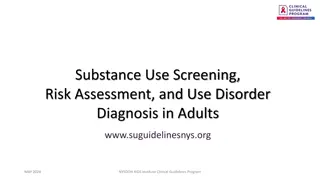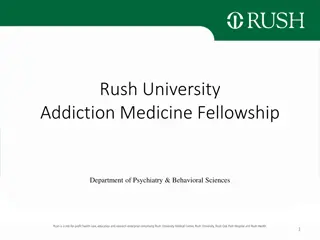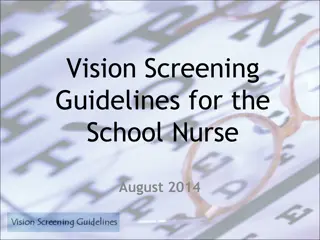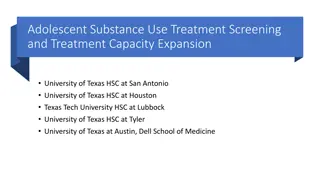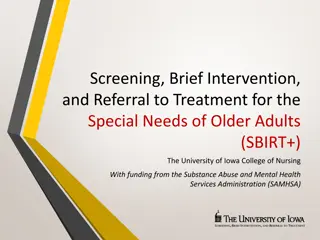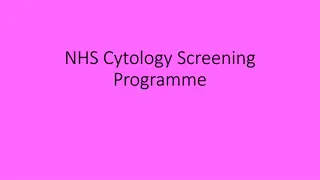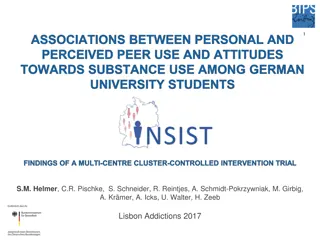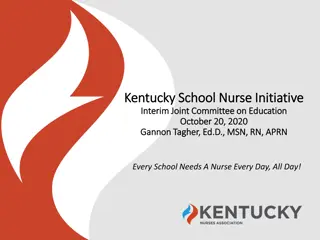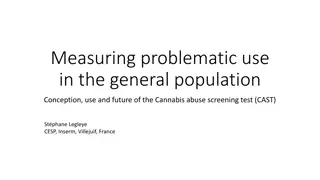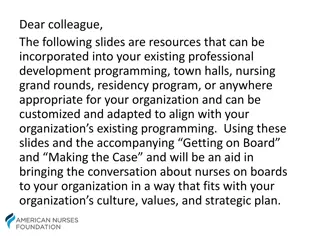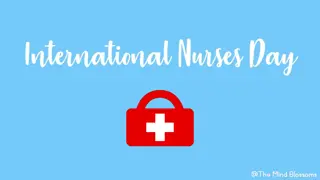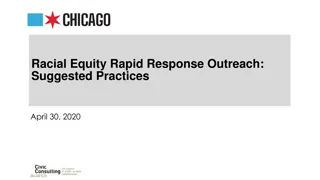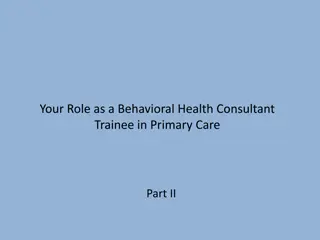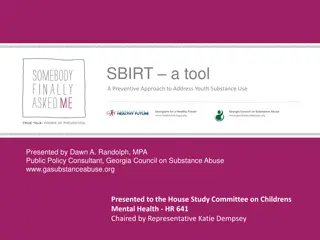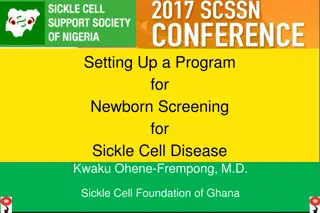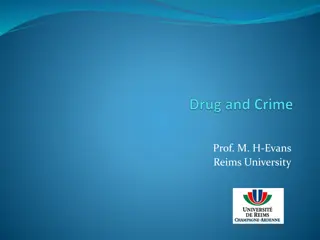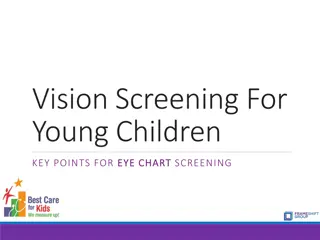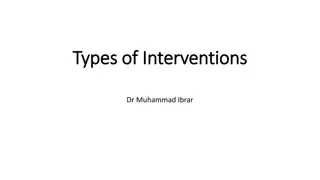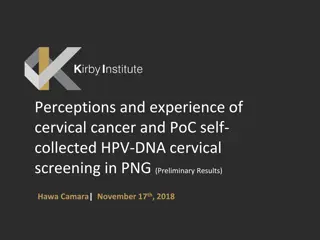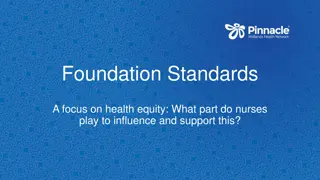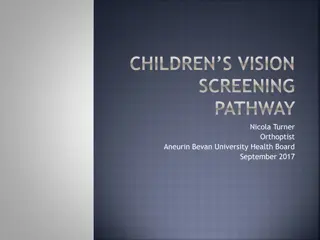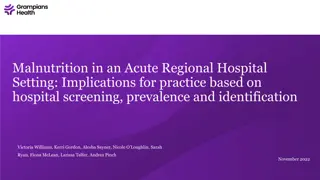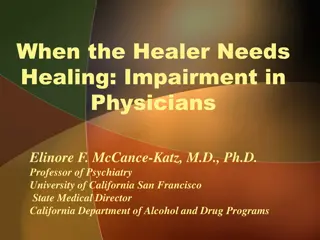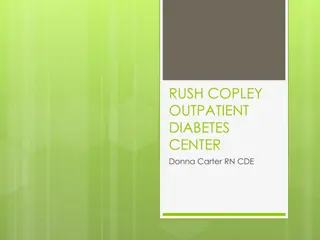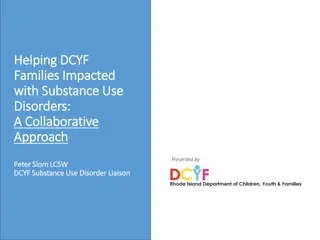The Role of Nurses at Rush University in Substance Use Intervention and Screening Program
The nurses at Rush University play a crucial role in the Substance Use Intervention and Screening Program Department of Psychiatry, focusing on SBIRT (Screening, Brief Intervention, Referral to Treatment) to identify and intervene with those at risk for substance use issues. The program utilizes Motivational Interviewing to facilitate behavior change, aiming to reduce harmful alcohol and drug use and improve overall public health outcomes. The importance of SUIT at Rush is underscored by the significant impact of substance use disorders on individuals, families, communities, and the healthcare system.
Download Presentation

Please find below an Image/Link to download the presentation.
The content on the website is provided AS IS for your information and personal use only. It may not be sold, licensed, or shared on other websites without obtaining consent from the author. Download presentation by click this link. If you encounter any issues during the download, it is possible that the publisher has removed the file from their server.
E N D
Presentation Transcript
The Role of Nurses at Rush University in Substance Use Intervention and Screening Program Department of Psychiatry Section of Population Behavioral Health
What is SBIRT? Screening: Universal screening for quickly assessing use and severity of alcohol; illicit drugs; and prescription drug use, misuse, and abuse Brief Intervention: Brief motivational and awareness-raising intervention given to patients at risk for substance use issues Referral to Treatment: Referrals to specialty care for patients with substance use disorders The Aim of SUIT is to Identify and effectively intervene with those who are at moderate or high risk for psychological or medical healthcare problems related to their substance use 2
Brief Intervention: Motivational Interviewing Motivational Interviewing (MI) is a collaborative communication style that is person centered and focused on behavior change. At the heart of MI is the spirit: Partnership: Viewing the person as being an expert on their own lives and that you are partnering with them. Acceptance: Remaining open to where the person is at in the change process and appreciating them as a unique human being. Collaboration: You are doing your best to demonstrate that you value the person s own ideas and are interested in what they have to say. Evocation: You are doing your best to elicit the person s own thoughts, ideas, perspectives, etc. prior to providing your own. The core skills are important as well: Asking open ended questions, affirming strengths, reflecting back the person s thoughts, ideas, feelings and summarizing to demonstrate understanding. 3
Why Is SUIT Important? Unhealthy and unsafe alcohol and drug use are major preventable public health problems resulting in more than 100,000 deaths each year. The costs to society are more than $600 billion annually. Rush University Medical Center reported approximately 562 Inpatient and 1011 outpatient encounters with a primary or secondary substance use diagnosis.
Why is SUIT Important at Rush? Effects of unhealthy and unsafe alcohol and drug use have far-reaching implications for the individual, family, workplace, community, and the health care system. Substance use disorders result from chemical changes in the brain and are a treatable physical disease Outcome data confirm a 40 percent reduction in harmful use of alcohol by those drinking at risky levels and positive benefits for reduced illicit substance use after SUIT engagement. 5
The Nurses Role in Screening in the SUIT Process At Rush 1. Nurses will ask all patients the two screening questions at inpatient admission 2. Nurses will document the responses to the screening questions in Epic 3. The Substance Use Column on the unit patient list will update according to the results of the 2-Question screening to prompt action from Unit based social workers 6
2- Question Screening in Epic Admission Navigator Needs Assessment Substance Use 7
2- Question Screening in Epic Inpatient Case Managers identify the patients with positive answers in a new Patient List column Substance Use The column displays three indicators: a. Patient answers 1 or more to any question Prompting social worker to further evaluate and intervene with DAST/AUDIT questionnaire and/or Brief Intervention b. Negative Screen. Patient answered None to both questions c. Blank - Screening was not completed on patient 8
What is a Positive Screen? Patients who answer 1 or more to either question will receive an a full screening through the automatic consult to Case Management Substance use 10
What Happens After a Patient is Referred to Case Management? Inpatient social workers will conduct a full screen using instruments AUDIT and/or DAST Questionnaire Inpatient social workers will engage patients in a brief intervention which involves using principles of motivational interviewing Patients identified with a substance use disorder will be referred to appropriate treatment in the outpatient setting 11
What happens if the patient or family asks questions about the next steps? Be caring and supportive Remain nonjudgmental and use reflective listening techniques Avoid stigmatizing terms like drug addict or abuse use term substance use disorder debunk myths such as once an addict always an addict Emphasize that the purpose of further screening is a best practice initiative and supports our ICARE values Patients will not be reported to the police Patients will play an active role in any possible treatment option Rush University is committed to offering help to patients who want it with evidence based treatment options 12
Additional Resources Substance Abuse and Mental Health Services Administration s (SAMHSA) Behavioral Health Treatment Finder Hotline and website: 1-800-662-HELP (4357) http://findtreatment.samhsa.gov/ Full Screening Tools AUDIT: http://www.sbirtoregon.org/wp-content/uploads/AUDIT-English-pdf.pdf DAST: http://www.sbirtoregon.org/wp-content/uploads/DAST-English-pdf.pdf More information about SBIRT and Motivational Interviewing Motivational Interview Video Demonstration: http://www.bu.edu/bniart/sbirt-in- health-care/sbirt-educational-materials/sbirt-videos/ 13


